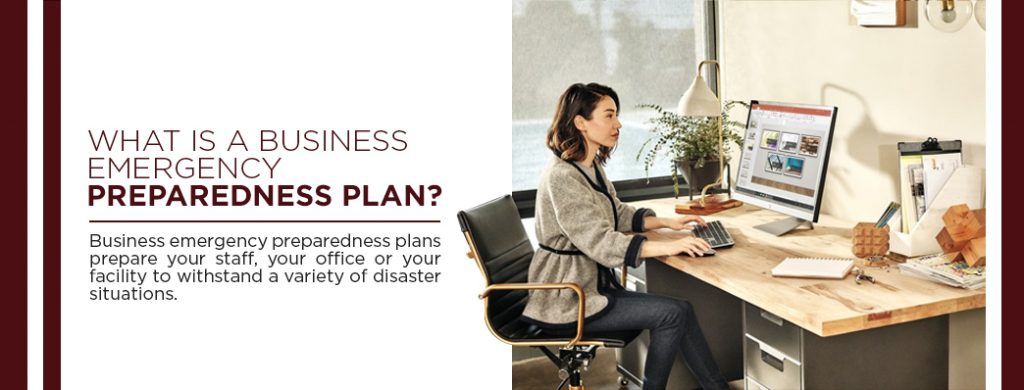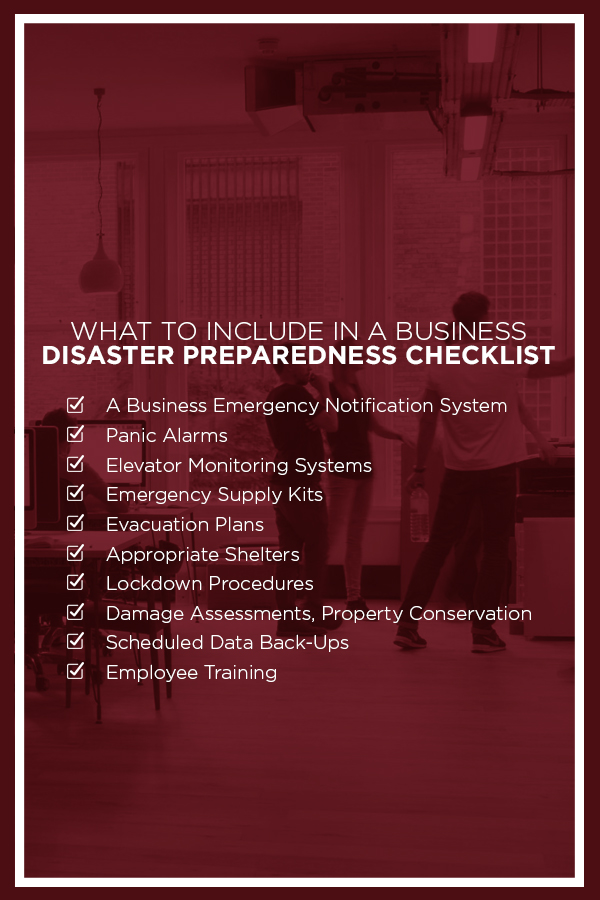
Table of Contents
Importance of Emergency Preparedness in the Workplace
Sure, practice fire drills and volunteer CPR classes are great. Yet what happens when your business faces real-time security, natural disaster or medical emergencies — emergencies that aren’t scheduled, scripted or cushioned by a safety instructor?
In the world of business emergency planning, there’s no such thing as being overprepared. Technology gives offices more tools than ever to create a tailored business emergency preparedness plan that sharpens situational know-how, protects vital business assets and saves lives. Best of all, they’re not complicated to implement.
Read on to see what a business emergency notification system and preparedness policy brings to your office — plus how to build one starting today.
What Is a Business Emergency Preparedness Plan?

Business emergency preparedness plans prepare your staff, your office or your facility to withstand a variety of disaster situations. When well executed, they mitigate the physical and emotional toll of experiencing emergencies at work. Plus, they protect that workplace from the long downtimes and overwhelming costs of replacing lost, damaged or irreversibly destroyed infrastructure — damage that could shut the business down.
For many industries, these plans are a matter of necessity. The Occupational Safety and Health Administration (OSHA) maintains broad and industry-specific guidelines on effective business emergency and communication plans, offering resources for businesses of all niches and sizes to build the core of their disaster preparedness checklist, including:
- Conducting risk assessments: To identify an organization’s most pertinent potential incidents, often related to your industry or your geographic location. For example, being prepared for chemical spills in a waste-treatment facility or having a tornado preparedness plan for an office in Oklahoma.
- Select response teams, leadership personnel: To initiate and oversee the response plan in the event of an incident, maintaining a sense of calm, stability and direction during these often-stressful times.
- Scaffold an action plan: To inform the step-by-step safety and security procedures protecting the workforce and facility.
The best business emergency response plans take a holistic rather than a microscopic approach to hazards planning. This assures speedy, proactive and intuitive responses to emergencies, increasing the likelihood of successful outcomes. Forcing employees to memorize a novel-sized list of individual threat plans and procedures tends to stifle morale and cause confusion, not capability, during an emergency — the opposite of what you want.
What Events Trigger Disaster Preparedness Plan for Business?
A handful of events qualify as true business emergencies in need of hazards planning and a timely emergency notification system:
1. Break-ins, Robberies and Security Breaches
There are roughly 2.5 million burglaries in the United States every year, with nearly a third of them targeting businesses. The aftermath of a break-in requires a detailed account of lost or damaged inventory. For companies, the most commonly robbed items during premise security breaches include:
- Money, namely from cash registers or safes
- Financial logs and other documentation, physical and digital
- IT hardware like laptops, computer equipment
- Retail merchandise, especially jewelry or electronics
2. Data Loss, Cybersecurity Incidents
Cybersecurity incidents are on the rise — and growing more complex. Research indicates it costs the average small business over $690,000 to recoup the losses from a data hack or security breach. Medium-sized businesses? That clean-up figure exceeds $1 million.
The financial ramifications of a cybersecurity incident threaten the very existence of businesses as well. When nearly 60 percent of organizations are forced to close shop within six months of experiencing a hack or attack, offices of all sizes must implement a cybersecurity preparedness plan to identify IT incidents when they occur, notify personnel, launch protective systems and remedy critical data loss.
3. Natural Disasters
Hurricanes, tornados, wildfires, floods, mudslides and extreme temperatures are only a few of the natural disasters requiring a business emergency notification system. While some of these events may be prepped for ahead of time, such as hurricanes, those preparations are made more efficient, more cost-effective and more comprehensive when backed by a set procedure.
4. On-Premise Accidents
Specific industries face higher risks of on-site or on-the-clock accidents. Emergency responses addressing them fall under workplace medical preparedness and are highly monitored by boards like OSHA.
Any organization with light or heavy operational machinery, vehicles, hazardous chemicals and confined space rescues have higher accident risks. Likewise, events like unplanned IT outages or on-site traffic accidents could also fall under this category, necessitating a step-by-step action plan.
5. Mass Messages for Business-Critical Communications
Emergency notification systems can also be used to send out critical messages to the entire workforce, all at the click of a button. This includes relaying the closure of a building, building policy reminders or updates on business-wide events. Likewise, a business’ emergency notification system can also notify personnel of critical infrastructure incidents, such as utility failures like power loss or sewage leaks.
Why Have an Emergency Preparedness Plan at Work?

Creating a company-wide emergency communication plan has more benefits than keeping your business on guard.
1. For Peace of Mind
Businesses with incident preparedness procedures have crossed their T’s and dotted their I’s. They’ve gone the extra step to ensure the safety and wellbeing of their staff comes first, followed by the technology and infrastructure that keeps their business going.
2. For Cost-Savings
How quickly — and how cost-effectively — a company can bounce back after a major incident is a reflection of its emergency preparedness. While accounting for every single possible natural disaster, security threat and emergency situation down to the last detail is impossible and ill-advised, general structures and teams should be ready to address incidents when they strike, saving time and money down the road.
3. For Compliance
As mentioned earlier, OSHA and other government agencies offer regulatory directions protecting the safety and wellbeing of employees in the workplace. This inevitably includes business emergency and communication plans that prioritize employee health. Organizations found not in compliance with OSHA worker safety standards risk severe fines and public-relations crises and jeopardize their very existence.
4. Because It’s the Right Thing
Organizations have an innate responsibility to give back to the employees who give so much to them. Workplaces should not be dangerous or hazardous environments where people are forced to risk their safety or happiness. Implementing a basic business emergency plan states you take your management role seriously, with nothing more essential to you than keeping colleagues protected.
What to Include in a Disaster Preparedness Checklist?

Ready to implement a business emergency communication plan in your office or workplace? Here are a few suggestions on the core elements to include.
1. A Business Emergency Notification System
Mass notification systems send instant alerts and updates to preset groups of employees. They are simple pieces of software companies install into their networks, giving them communication access to specific employee lists — or the entire workforce.
Mass emergency notification systems are particularly effective communication tools across the following situations:
- Emergency evacuations
- Building lockdowns
- Severe weather alerts
- Directions to designated building shelters
- Hazardous material releases or spills
- On-site accident notices
- Traffic or transportation incidents
- Building event updates
Emergency and non-emergency mass notifications can be customized across messaging formats and volumes, too:
- Text (SMS Messages): High-capacity emergency text messages, like Towne Business Monitoring’s Express Message, allows you to send up to 10,000 texts in an hour to pre-programmed or ad-hoc created groups.
- Phone calls: Express Message affords 5,000 outgoing phone calls per hour as well as inbound call processing during emergencies.
- Emails: The same system can additionally manage and send an unlimited number of instant emergency notifications straight to employee inboxes.
2. Panic Alarms
Panic alarms aren’t just for banks or retail stores with cash registers. Today, alarms have graduated to custom digital and touch alerting systems with a range of features and applications, including:
- Reception areas
- Employee desks or work stations
- Employee break rooms
- Near building entries and exits
- Public wait rooms
- During lightly staffed business hours
Products like Towne Business Monitoring’s Panic Alarms operate in complete silence. Users only have to reach out and press the nearest pendant’s “Help” button, among other button add-ons, to connect with a system operator. That operator cannot be heard and the pendant system makes no noise during use, yet the emergency operator can listen in and hear what is taking place on your end. Operators are trained in call-escalation procedures and can notify relevant first responders during pressing security threats.
3. Elevator Monitoring Systems
Up-to-code elevators must contain a “Help” button connecting passengers to a 24/7-operated assistance line. In the event of an elevator emergency, these call button alerts should be set up for two-way communication as well as for operators to geotrack the location of the elevator to dispatch mechanics or first responders.
Elevator monitoring systems are an essential part of an office’s overall emergency response infrastructure. They are affordable and straightforward installations that can be managed in-house or by a third-party partner, like Towne’s Business Monitoring.
4. Emergency Supply Kits
Supply kits contain food rations, water and basic supplies needed in case employees are stranded during an emergency. Kits are most pertinent for businesses affected by severe weather, such as hurricanes, tropical storms and blizzards.
Emergency supply kits should outfit your business with rations for a minimum of 72 hours. Each should include:
- One gallon of water per person, per day
- Non-perishable food items
- Battery-powered radio with a National Oceanic and Atmospheric Administration (NOAA) Weather Radio tone alert
- First aid kit
- Flashlights
- Extra batteries
- Basic tool set
- Plastic garbage bags and other sanitation supplies
- Cell phone charger
5. Evacuation Plans
Considered a part of protection for life safety, evacuations routes are a top element to highlight in your emergency communication plan.
Include a minimum of two routes of travel per room or floor plan, if not more. Outline procedures and personnel responsible for assisting guests out of the building, as well as those with disabilities or mobility impairments. Evacuation plans should also name a designated accounting location where employees congregate after a safe building evacuation.
6. Appropriate Shelters
There are two forms of shelter for a business’ emergency communication plan and mass message system to take into account:
- Shelter-in-place: As the name suggests, shelters-in-place are rooms or structures within your building designed to weather natural disasters. These might include storm shelters, earthquake shelters or tornado-resistant areas like basements or windowless rooms.
- Accounting shelters: Accounting shelters refer to the designated accounting areas to check-in after building evacuation. They can be as simple as a segment of the parking lot to an entirely different building down the street.
7. Lockdown Procedures
Lockdown protocol should be initiated as a protective measure when your organization is facing an act of violence.
Though difficult to think about, lockdowns are a necessary measure to secure boundaries and protect your employees. Consider them the yin to your evacuation plan’s yang — while evacuation plans outline safe routes to exit a building, lockdown plans relay the steps taken to safely barricade or secure yourself in the area you currently are. Together, they lend your employees fundamental knowledge on what to do and where to be regardless of emergency type.
8. Damage Assessments, Property Conservation
Business emergency preparedness plans also account for what happens after an incident, particularly if physical objects and building infrastructure have been damaged. Damage assessments minimize further office havoc, itemize losses for insurance claims and get the entire place back on its feet.
Formal damage assessments allow designated personnel to account for:
- Permanently damaged office objects or systems
- Salvageable office goods
- Reinstatement of undamaged materials or property
- Building clean-up
9. Scheduled Data Back-Ups
Regularly backing up your enterprise data is not an empty IT best practice. When many of the emergencies described above — from natural disasters and cybersecurity incidents to theft — strike, it’s often on-premise hardware and network systems that take the biggest hit.
Data loss frequently becomes a business’ kryptonite. Research shows recovery and reinstallation costs over $140 per data record. At the very least, business processes are disrupted as an organization scrambles to access and reinstate its critical data. At most, it loses so many core pieces of information, documents and programs, it can no longer conduct further business.
Scheduling regular, consistent data back-ups assures that no matter what happens to your software and hardware, enterprise data is never lost.
10. Employee Training
Last but not least, an effective emergency communication plan should always involve employee education. Training sessions should focus on core preparedness areas, such as medical emergencies, lockdown protocol, building evacuation routes and in-house shelters. They should also appoint emergency response teams and team leaders who will be the main points of contact during incidents, maintaining calm control.
How to Communicate During a Disaster or Emergency
If you’ve been included in an emergency response team, it’s essential to remember these simple steps to smoothly and decisively fulfill your safety role:
- Breathe: It’s natural to enter a high-stress mental and emotional state when unexpected emergencies happen. When in doubt, remind yourself you and the business have prepared for this, with tools and resources right there, in place.
- Send out the appropriate emergency notification: Use your organization’s mass messaging system to relay email, phone and text alerts to all relevant personnel.
- Address life safety: Life safety matters are exactly as they sound — prioritizing activities and actions that ensure minimal physical danger for your employees or colleagues. Life safety activities should be at the forefront of business emergency preparedness methodology, with things like evacuation plans and emergency kits as examples.
- Stabilize the situation: Many actions can be taken to minimize damage and assert situational control — administering first aid, directing employees to exit route, assisting confused guests, escorting persons with disabilities, disconnecting utilities, distributing protective equipment and more prevent damage and chaos from escalating.
- Secure assets: If possible, ensure high-valuable assets like computer systems, expensive retail merchandise or important business documents are safely stored or otherwise transported off-premise during an emergency.
Create Your Business’ Emergency Notification System and Communication Plan Today

The logic is simple: At the end of the day, it’s universally wiser for business to be proactive rather than reactive to life’s emergencies — for their reputations and their your wallet.
Contact the security and stability experts at Towne’s Business Monitoring to review emergency devices and monitoring systems for your office today. Over 60 years in business means time-tested mass-messaging systems, office help buttons, elevator monitoring services and more are available to add to your disaster or emergency preparedness checklist.